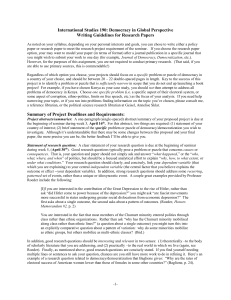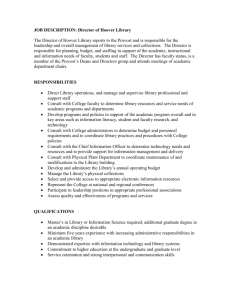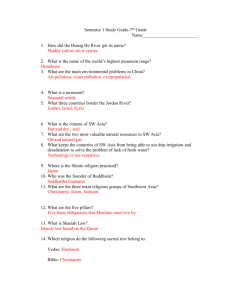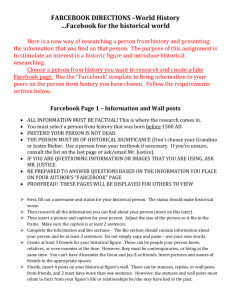policy paper guide - Division of Social Sciences
advertisement
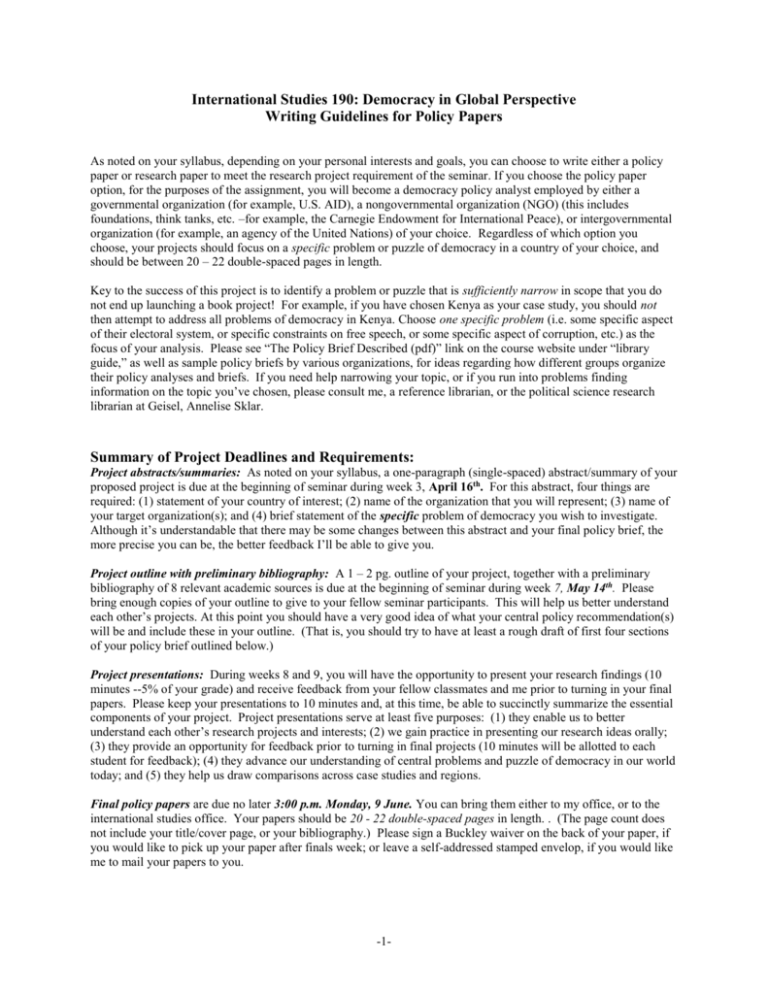
International Studies 190: Democracy in Global Perspective Writing Guidelines for Policy Papers As noted on your syllabus, depending on your personal interests and goals, you can choose to write either a policy paper or research paper to meet the research project requirement of the seminar. If you choose the policy paper option, for the purposes of the assignment, you will become a democracy policy analyst employed by either a governmental organization (for example, U.S. AID), a nongovernmental organization (NGO) (this includes foundations, think tanks, etc. –for example, the Carnegie Endowment for International Peace), or intergovernmental organization (for example, an agency of the United Nations) of your choice. Regardless of which option you choose, your projects should focus on a specific problem or puzzle of democracy in a country of your choice, and should be between 20 – 22 double-spaced pages in length. Key to the success of this project is to identify a problem or puzzle that is sufficiently narrow in scope that you do not end up launching a book project! For example, if you have chosen Kenya as your case study, you should not then attempt to address all problems of democracy in Kenya. Choose one specific problem (i.e. some specific aspect of their electoral system, or specific constraints on free speech, or some specific aspect of corruption, etc.) as the focus of your analysis. Please see “The Policy Brief Described (pdf)” link on the course website under “library guide,” as well as sample policy briefs by various organizations, for ideas regarding how different groups organize their policy analyses and briefs. If you need help narrowing your topic, or if you run into problems finding information on the topic you’ve chosen, please consult me, a reference librarian, or the political science research librarian at Geisel, Annelise Sklar. Summary of Project Deadlines and Requirements: Project abstracts/summaries: As noted on your syllabus, a one-paragraph (single-spaced) abstract/summary of your proposed project is due at the beginning of seminar during week 3, April 16th. For this abstract, four things are required: (1) statement of your country of interest; (2) name of the organization that you will represent; (3) name of your target organization(s); and (4) brief statement of the specific problem of democracy you wish to investigate. Although it’s understandable that there may be some changes between this abstract and your final policy brief, the more precise you can be, the better feedback I’ll be able to give you. Project outline with preliminary bibliography: A 1 – 2 pg. outline of your project, together with a preliminary bibliography of 8 relevant academic sources is due at the beginning of seminar during week 7, May 14th. Please bring enough copies of your outline to give to your fellow seminar participants. This will help us better understand each other’s projects. At this point you should have a very good idea of what your central policy recommendation(s) will be and include these in your outline. (That is, you should try to have at least a rough draft of first four sections of your policy brief outlined below.) Project presentations: During weeks 8 and 9, you will have the opportunity to present your research findings (10 minutes --5% of your grade) and receive feedback from your fellow classmates and me prior to turning in your final papers. Please keep your presentations to 10 minutes and, at this time, be able to succinctly summarize the essential components of your project. Project presentations serve at least five purposes: (1) they enable us to better understand each other’s research projects and interests; (2) we gain practice in presenting our research ideas orally; (3) they provide an opportunity for feedback prior to turning in final projects (10 minutes will be allotted to each student for feedback); (4) they advance our understanding of central problems and puzzle of democracy in our world today; and (5) they help us draw comparisons across case studies and regions. Final policy papers are due no later 3:00 p.m. Monday, 9 June. You can bring them either to my office, or to the international studies office. Your papers should be 20 - 22 double-spaced pages in length. . (The page count does not include your title/cover page, or your bibliography.) Please sign a Buckley waiver on the back of your paper, if you would like to pick up your paper after finals week; or leave a self-addressed stamped envelop, if you would like me to mail your papers to you. -1- Basic Components of Policy Papers: The following guidelines below are designed to assist, not constrain, you in researching and writing your policy analyses. I. Cover Page: Your cover page should include the following information: 1. Title of your brief (be creative –make it compelling!). 2. Your name. 3. The name of the organization you represent. 4. The name of your target organization(s). (That is, these are the group(s) you hope will adopt your policy recommendations. In some cases, your pitch could be made to the organization you work for –that is, an internal policy brief; but in most cases it will be another organization, government agency, branch of an international organization, etc.) 5. Executive Summary: A brief, single-spaced summary of the policy paper’s purpose and recommendations. (Typical summaries do not exceed approximately 150 words.) II. Body of Policy Brief: Feel free to use the following five components for phrasing sub-headings in your policy briefs: 1. Statement of Issue/Problem: The purpose of this section is to convince your target audience that the problem you are presenting is important and requires their urgent attention and action. This section should: Introduce the specific problem or puzzle of democracy you’ve chosen; State why it’s important. Summarize the structure of your paper. Summarize your conclusions. 2. Origin/History of the Problem: This is a very important part of your analysis and will require you to do some historical research into the root cause(s) of the problem you have identified and its history in your chosen country. You should consult a minimum of three sources (with varying perspectives), and then put forth your own assessment of the priority of cause(s). 3. Critique of (Previous and/or Existing) Policy Options: Depending on the problem you’ve chosen, this section will either: Provide a brief history of previous, but failed, policies in addressing the problem. In this case, you’ll simply need to provide a brief critical discussion of the policies and why they’ve failed (limit your critique to no more than 3 policies). Or: If the problem is one that has not yet been addressed by policymakers, but different policies have been put forth by an array of interested actors, provide a brief critique of these options. That is, from the perspective of the organization that you’ve chosen to represent, address advantages and disadvantages of each of these policy options. (Again, limit your critique to 3 policies.) 4. Statement of Policy Recommendation(s) and Analysis of Challenges to Implementation: This section should provide a detailed and convincing proposal of the policy option(s) you recommend to address the problem. It could be one of the options you’ve already discussed above, perhaps with some modification; or something entirely new. Your recommendations should provide a breakdown of specific practical steps that need to be taken and should speak to the following questions: 1. How will the policy address the origins/history of the problem you discuss in Section 2? 2. How will the policy address either failed or otherwise inadequate policies discussed in Section 3? 3. How will potential short and long-term challenges/obstacles (i.e. political, economic, social, cultural, etc.) to policy recommendations/implementation be overcome? -2- Please note that your arguments should be empirically and analytically based, and supported by compelling evidence and careful analysis of existing research. 5. III. Conclusion: Your conclusion should summarize your findings and reiterate the importance of action to your target group. Depending on the problem/puzzle of democracy you choose, and your target audience/organization, you could address how your policy recommendation(s) are either in agreement with or depart from past policy perspectives, and why they should change their position on the issue. Bibliography, Citations and Footnotes: Please consult a minimum of ten relevant academic sources, in addition to assigned course readings, for your projects. These sources can either be books, articles from scholarly journals, other policy briefs, organizational reports, or primary sources or materials from authoritative websites. (See research links on the course website for assistance with this.) The preferred formatting for references is Chicago Manuel of Style with formal footnotes (as opposed to endnotes or in-text citations). If you are not yet familiar with this style, please consult their website: http://www.chicagomanualofstyle.org/tools_citationguide.html (Note that the preference is for “N” (footnotes) and “B” (bibliographic entries), not for “T” (in-text citations) and “R” (references).) You can also consult me, or one of the research librarians for any assistance with this. A Few Notes on Citations: 1. It is very important to give proper credit to the sources of your ideas. This is not only important in order to give credit where credit is due, but it also lends greater credibility to your own argument(s) and points your readers to further reading should they want to pursue a point you raise in greater detail. One way to understand your task as a writer is that you are in conversation with other writers and thinkers who have explored similar ideas and concerns. Even if you use your own words to summarize someone else’s ideas, you still need to cite the source of your ideas. In addition, if more than one scholar supports the general argument you make, be sure to list these scholars, their relevant works, page numbers, etc. in your footnote(s). If you have any questions about proper citations, please see the reference guides listed below, or ask me, or one of the research librarians at Geisel library. 2. If you use direct quotations, be sure to introduce and contextualize these quotes. For example: As Bates argues, “yadda, yadda, yadda…” Or: As Martin “contends,” or “suggests,” or “insists,” etc. This way, quotations are not left hanging, and your reader gets the sense that you are, in fact, in conversation with these other scholars. If a quotation exceeds three lines, both left and right margins should be indented, and the quotation should be singlespaced. (That is, it should be written as a “block quote.”) 3. Because of the importance of properly citing your sources, I will be quite strict in grading this component of your paper. If you have any questions at all, please consult the Chicago Manual of Style web-link, me, or one of the research librarians. In addition, if you have any questions about when and how to cite, please consult the following reference on reserve for the course: Lisa A. Baglione, Writing a Research Paper in Political Science: A Practical Guide to Inquiry, Structure and Methods, Thomas Wadsworth Press, 2007. For citations, see especially pp. 52 – 55. IV. Optional: You may also choose to include tables, maps, or figures within the text of your analysis, or as an appendix at the end of your paper. Some Further (Final) Tips for Writing Excellent Papers: Start with a first draft: Try to complete this draft approximately one week before your final paper is due. As they say, write early and often! Write a second (or more) draft(s): Once you have a good idea of what it is you want to say, re-write your paper from beginning to end, ensuring that all the key components discussed above are included. Be brutal as you proofread your work. Is the -3- evidence you present persuasive? Does it clearly support your central argument? Does each paragraph contain a topic sentence or idea and supporting evidence? Does each paragraph logically connect to the next? Have you acknowledged important counterarguments and presented evidence that clearly refutes them? Is your evidence specific and concrete? As Strunk and White recommend, “[p]refer the specific to the general, the definite to the vague, the concrete to the abstract.” (Strunk and White, p. 21). Is your language concise? As Strunk and White also point out, “[v]igorous writing is concise. A sentence should contain no unnecessary words, a paragraph no unnecessary parts.” (Strunk and White, p. 23). Proof-read your work: Once you have completed a final draft of your paper, carefully proofread your work one more time. Check for grammatical and spelling errors, and/or sentences that might read awkwardly. Best of luck, have fun, and please consult me, or any of the research librarians at Geisel, if you run into problems, need to brainstorm, etc.! -4-
